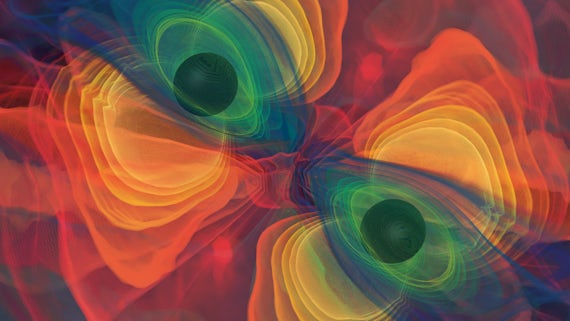Binary black hole modelling

Our researchers play a leading role in developing state of the art binary black hole waveform models.
The most pressing current scientific application of numerical relativity is to the last orbits and merger of two black holes. A black-hole-binary merger was the source for the first direct detection of gravitational waves which constituted the first direct observation of black holes.
Our efforts have been focused on the modelling of the gravitational-wave signals from black-hole mergers. This involves synthesizing the results from numerical simulations into analytic models, but also determining the necessary accuracy requirements of the waveforms and the final models, the particular binary configurations to study, and how to extract their basic phenomenology from the simulations.
Ultimately this means calculating and interpreting the physics of black holes in the highly dynamical regime directly before and after a merger, when the two black holes can undergo wild complex orbits (due to spin effects), and the final black hole emits a complicated waveform pattern as it rapidly 'spins down' to a stationary Kerr black hole.
Our research
In collaboration with the University of the Balearic Islands (UIB), we have recently produced the most accurate and complete model to date of the gravitational wave signal from binaries that follow simple non-precessing orbits.
We have also pioneered a novel technique to model general 'precessing' binaries (where the black-hole spins can point in arbitrary directions, and the binary may follow wild, complicated orbits before merger), which is used in all precessing-binary models currently in use.
This work led to a generic-binary model, 'PhenomP' which is the only model accurate and efficient enough to be used to measure the masses, spins and location of any black-hole-binary detected in advanced Laser Interferometer Gravitational-Wave Observatory (LIGO) data.
These models are built from numerical solutions of Einstein's equations for the last orbits and merger of black-hole binaries.
Related publications
- Khan, S. et al., 2016. Frequency-domain gravitational waves from nonprecessing black-hole binaries. II. A phenomenological model for the advanced detector era. Physical Review D 93 (4) 44007. (10.1103/PhysRevD.93.044007)
- Hannam, M. et al. 2014. Simple model of complete precessing black-hole-binary gravitational waveforms. Physical Review Letters 113 (15) 151101. (10.1103/PhysRevLett.113.151101)
- Schmidt, P. , Hannam, M. and Husa, S. 2012. Towards models of gravitational waveforms from generic binaries: A simple approximate mapping between precessing and nonprecessing inspiral signals. Physical Review D 86 (10) 104063 (. (10.1103/PhysRevD.86.104063)
LIGO scientists detect gravitational wave signal from the merging of two black holes.


